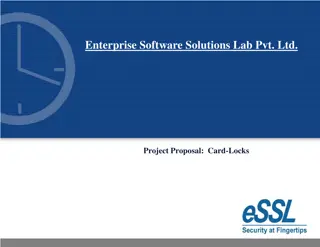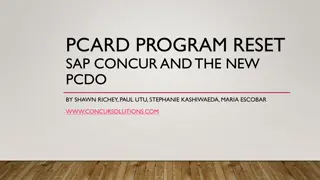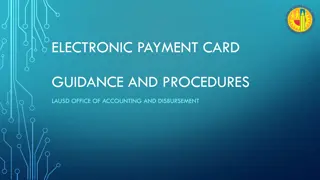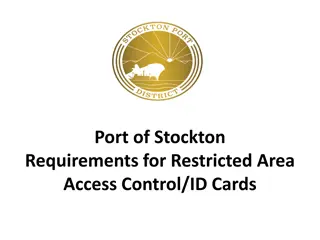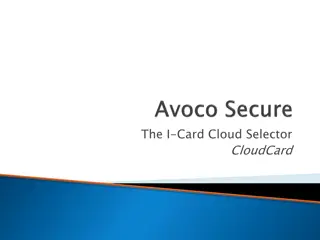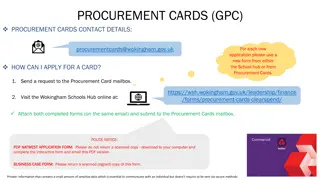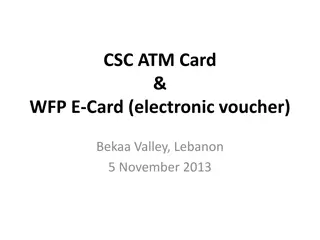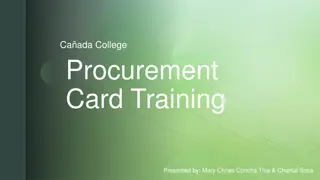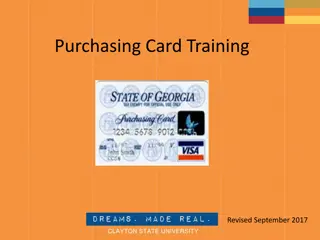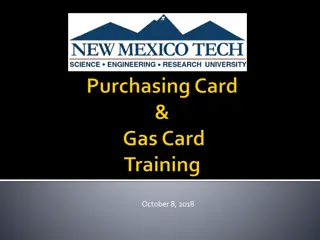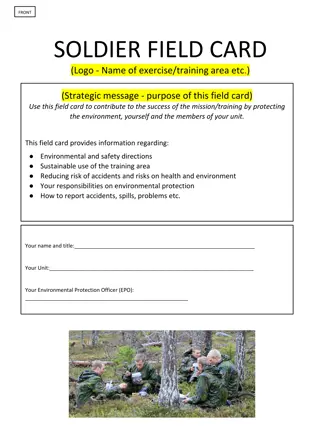Enhancing Your P-Card Program: Best Practices and Strategies for Success
Explore key insights and strategies presented at the West Virginia ASBO Fall Conference 2020 by Linda S. Johnson on optimizing Purchasing Card Programs. Learn about evaluating existing programs, setting goals, important objectives, and research opportunities for continuous enhancement.
Download Presentation

Please find below an Image/Link to download the presentation.
The content on the website is provided AS IS for your information and personal use only. It may not be sold, licensed, or shared on other websites without obtaining consent from the author. Download presentation by click this link. If you encounter any issues during the download, it is possible that the publisher has removed the file from their server.
E N D
Presentation Transcript
Purchasing Card Best Practices West Virginia ASBO Fall Conference 2020 Presented by: Linda S. Johnson, CPCP
Learning Objectives Learning Objectives Learn how to evaluate your existing P-Card Program to ensure it is providing the greatest return in efficiencies, expense reduction, and rebate potential Understand what practices you can implement to optimize and expand your P-Card Program Gain applicable knowledge of the activities that best-in-class P-Card Programs utilize
Why are they important? Why are they important? Need Benefit Streamlined Procure to Pay Processes P-Cards reduce manual processes and processing cost Compliance Better spend controls minimize or eliminate spending abuse Reconciliation Enhanced data for financial systems ties payment to specific events or cost codes Better Economics Card spend provides supplier discounts and financial rebates, while reducing processing cost
Establish Goals and Objectives Establish Goals and Objectives Leading agencies establish measurable goals and objectives Must comply with legislation for purchasing products and services Modify procure-to-pay functions to achieve goals and objectives Adjust goals and objectives as program evolves and changes
Typical Goals and Objectives Typical Goals and Objectives Improve level of accountability and control Lower transaction cost per purchase Increase discounts received from suppliers Reduce number of invoices processed by accounts payable department Increase visibility into potential misuse of taxpayer dollars Minimize invoice payment processing time and errors Improve employee purchasing efficiency Reduce cycle time for acquiring products and services Reduce number of purchase orders and vendor checks issued
Research Opportunities Research Opportunities Leading agencies understand the benefits and value of P-Cards and research opportunities for continuous improvement Analyze current procure-to-pay process for efficiencies and cost savings Determine P-Card s place within your payment strategy Seek innovative applications
Management and Oversight Management and Oversight Assignment of oversight to the appropriate Program Coordinator(s) is critical for guiding and executing P-Card initiatives and overall program success Knowledgeable of procure-to-pay process Authority to make decisions to improve program Administer day-to-day functions Delegate duties to assist in reconciliation, reviewing, approving and monitoring processes
P P- -Card Policies and Procedures Card Policies and Procedures Develop a comprehensive Policies and Procedures Manual to establish and communicate the program guidelines and appropriate use of the P-Card Establish rationale for using P-Cards Explain how P-Cards fit into current procure-to-pay processes Set the control environment Outline requirements for usage, training, transaction review and auditing Define consequences for fraud, misuse, and abuse Update and regularly distribute to encourage understanding and compliance
Policies and Procedures Key Components Policies and Procedures Key Components Program overview and objectives Coordinator and Approvers responsibilities Cardholder responsibilities Approval process Reconciliation process Credit/ Ordering and payment procedures Eligible purchases Record retention Security and Liability Transaction/ Spending limits Dispute resolution and lost card procedures Auditing and controls procedures Restricted transactions Card issuance and activation Training requirements
Policies and Procedures Minimum Requirements Policies and Procedures Minimum Requirements The State Auditor s Office has established minimum standards for the use of the Local Government P-Card Policies and Exhibits located on the WVSAO website under the Local Government P-Card Tab WVSAO website: www.wvsao.gov Policies and Procedures updated September 2020 Cardholder Agreement updated September 2020 (Program coordinator signature no longer required)
Control Environment Control Environment Leading agencies establish strong control and oversight policies and procedures while maintaining flexibility and ease of card use Establish controls that increase visibility and minimize inappropriate use of public funds Ensure separation of duties Develop a plan for frequent internal monitoring and auditing to prevent and detect fraud, misuse and abuse Establish appropriate level of control and oversight while promoting the expansion of P-Card use
Control Environment Control Environment Strike a balance between control and use Excessive controls restrict p-card usage, are time consuming, and costly Institute controls that ensure compliance with procurement policies and procedures, auditing and statutory requirements
Technology Technology Leading agencies effectively utilize technology Improve account management Reduce reconciliation timeframe Automate cost allocation process Integrate transaction data with accounting system Lower administrative and operational cost Enhance data analytics Streamline business processes (Improved accuracy, reporting, controls, and performance measurement)
Technology Technology Smart Data Cardholder Portal Payment Portal Fifth Third Direct Cost allocation Reconciliation Transaction review/approval Interface with accounting system Reporting Monitoring and Auditing Card declines Review transactions Available balance Statements Change PIN Submit payment New accounts Maintain cards Replacement cards Card declines Review transactions Statements
Training Training Leading agencies develop a training program to regularly educate all participants involved in the P-Card Program Train before cards are released Refresher training as policies and procedures are updated and when cards renew Utilize multiple training methods (Online, In person, Classroom)
Training Topics Training Topics Procurement procedures and processes Policies, Procedures and Rules How the program operates Proper card usage Roles and responsibilities Required documentation P-Card technology Consequences for noncompliance, misuse, and abuse Ethics
Communication Communication Develop and implement a communication plan to provide program progress, new policies and procedures, cost savings, and other successes Management endorsement of the program by mandating use of P-Cards for the targeted expenditures P-Card Program justification, goals, benefits, and controls to all participants Mutual benefits with suppliers Importance of procurement and accounts payable working together to incorporate P-Card acceptance in contracts Participate in knowledge-sharing forum
Roles and Responsibilities Roles and Responsibilities Defining roles and responsibilities up front is key to a successful P-Card Program Ensures all program participants have a clear understanding of the program s structure and their responsibilities Coordinators Cardholders Sub Coordinators/Reviewers/Approvers Auditors
Roles and Responsibilities Roles and Responsibilities Coordinators: Establish policies, internal controls, structure, vision, management oversight, etc. Complete day-to-day card management activity. Adjust limits, remove restrictions, order cards, suspend cards, activate cards, information changes Provide policy and operational guidance Ensure all participants receive mandatory training Cost allocation, statement reconciliation, payment to card provider Report cases of misuse or abuse
Roles and Responsibilities Roles and Responsibilities Cardholders: Complete required training before using card Read and sign Cardholder Agreement Comply with policies and procedures and internal controls Adhere to purchasing policies and guidelines Obtain itemized documentation Assign correct cost allocation codes Reconcile statement within set deadline Report a lost or stolen card Report fraudulent and unauthorized transactions Sign statement/log sheet
Roles and Responsibilities Roles and Responsibilities Sub Coordinators, Reviewers, and Approvers: Review transactions for misuse, abuse, and fraud Ensure proper approval and supporting documents were obtained for transactions Reconcile master statements for assigned department/school Issue payments to financial institution
Roles and Responsibilities Roles and Responsibilities Auditors: Review cardholder transactions to ensure policy and procedure compliance Verify purchase within scope of job duties Continuous internal monitoring of transactions to deter fraud, misuse, and abuse Review to ensure compliance of the overall program processes
P P- -Card Optimization Card Optimization Leading agencies strive to continuously improve their P-Card Programs by periodically reviewing to measure the health of the program in order to optimize the benefits of utilizing P-Cards
Optimization Are P-Card goals and objectives being achieved? What changes need to be made to improve efficiency? Are we effectively using technology? What processes can be automated?
P P- -Card Growth Card Growth Leading agencies explore ways to grow their P-Card Program to increase the benefits and improve procurement efficiency Add card variations Increase types of purchases made on the P-Card Convert more suppliers to P-Card payment Reduce paper in administration and accounting processes Improve 1099 and sales tax management Incorporate P-cards into disaster preparedness and business continuity planning
Summary Maximizing P-Card performance involves a concerted effort across multiple departments in School Systems. Coordinators of leading P-Card Programs continually apply best practices and forward-thinking strategies to improve functional efficiency, growth and cost reduction. There are many variables that influence a program's success. Monitoring a few key metrics on a regular basis can provide insight into a program s performance that enables you to make informed decisions about where to focus resources.
Thank you for attending Thank you for attending Please do not hesitate to reach out if you have any questions or would like additional information pertaining to the P-Card best practices shared today Linda S. Johnson, CPCP Assistant Director, Local Government P-Card Division Email: Linda.Johnson@wvsao.gov Telephone number: 304-618-0050
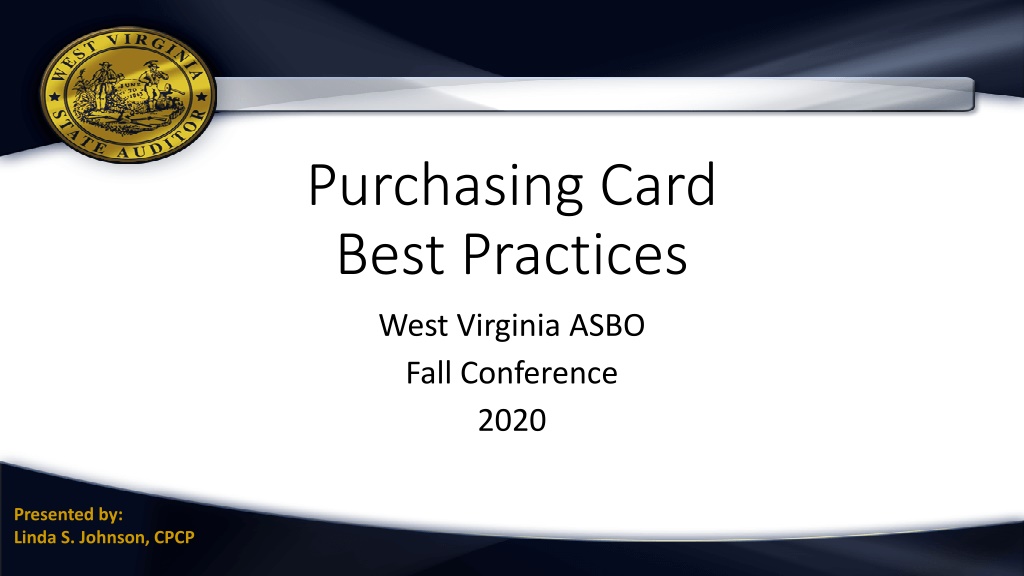



![Guardians of Collection Enhancing Your Trading Card Experience with the Explorer Sleeve Bundle [4-pack]](/thumb/3698/guardians-of-collection-enhancing-your-trading-card-experience-with-the-explorer-sleeve-bundle-4-pack.jpg)

